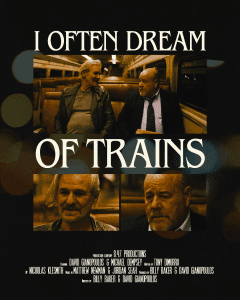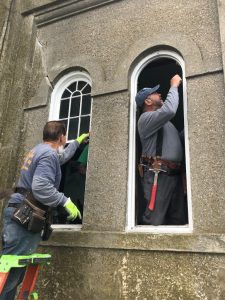By John L. Turner

I became excited at discovering the four large plywood boards laying in the woods at the edge of a Town of Brookhaven preserve in Coram. While the dumping of the material was a thoughtless and selfish act by some careless individual, I knew the four boards laying haphazardly on top of each other nevertheless provided an opportunity to see what was living beneath, as boards like this create habitat that a number of different animals like to use. I was not to be disappointed.
Lifting up the top board until it was vertical along its long side, I peered down to see a curled up Ring-necked snake. A little more than a foot long and the thickness of your pinky, the ring-necked lives up to its name with a bright yellow ring around its neck matched by a pretty yellow belly. The top of the snake is grey (in other individuals I’ve seen the dorsal or top side is more like a muted mauve color) making for an attractive if diminutive serpent. The snake moved off the board giving me the opportunity to lift the next one — which revealed a few crickets but no snakes.

I leaned the second board up against the first and slowly turned over the third board — success! Laying there in the middle of the damp board was a slightly curled milk snake. The milk snake is highly attractive, possessing irregularly shaped burgundy colored splotches on its back and sides which are outlined in black on a base of white. The extent of the splotches makes the white in between look like rings or bands. Milk snakes get their name because they were once common around milking barns or cow sheds where they fed on the small mammals plentiful there.
Of the seventeen snake species found in New York State, eleven are native to Long Island — besides the two aforementioned species, others are the Northern water snake, smooth green snake, Eastern hognose snake, the Northern brown or DeKay’s snake, Northern redbelly snake, Eastern worm snake, Northern Black Racer, common garter snake, and its cousin — the Eastern ribbon snake. We once had a twelfth snake, a venomous one — the timber rattlesnake but this species has been extirpated from Long Island due to a combination of direct persecution and habitat destruction.
According to an article on rattlesnakes written by Richard Welch, published in the Long Island Forum: “Between 1869 and 1899, fifty timber rattlesnakes were killed on or near the grounds of the South Side Sportsmen’s Club.” The Club is now Connetquot River State Park. The last known individual was killed around 1912 apparently while sunning itself on the railroad tracks in Oakdale.
Welch concludes his article: “On fish-shape Paumonauk, the buzz of crotalus’ rattle is only a ghost in the woods,” crotalus being the genus to which the timber rattlesnake belongs.

My holy grail of Long Island snakes long has been the smooth green snake. This beautiful tropical looking species, lime green with yellow tinges on the lower sides with white on the bottom, is a snake I’ve wanted to see on Long Island for at least 50 years and finally on May 20, 2025 I found one, tipped off to the spot by another individual interested in snakes! I celebrated with a tasty beer that night. Green snakes were once relatively common on Long Island but has become increasingly rare due to the dual impacts of habitat destruction and pet collecting and is now reported from just a few locations on the island.
Black Racers live up to their name, being able to move at remarkable rates of speed when pressed, an activity which I’ve seen twice with glossy black serpents looking supercharged heading off through a thicket of blueberry thickets. They also are able climbers and I once watched a Black Racer climb a multi-flora rose bush in a field in Yaphank in just a few seconds, avoiding thorns as it went, honing in on a bird’s nest to look for eggs or hatchlings — it was out of luck as the nest turned out to be empty, one that was probably used the year before.
The Eastern hognose snake is another species that has become increasingly rare here. So named because of its upturned snout like a hog, this species is an eater of toads and a dweller of sandy habitats, and often displays a behavior when disturbed that’s right out of a Disney movie.
When agitated the snake at first may lunge at the object causing the disturbance; this is a bluff as the mouth stays closed. Then often but not always the hognose begins to writhe spasmodically going into its “death throes,” turning belly up and flaying its tongue out of its mouth. Sometimes there’s blood in the corner of its mouth because of capillaries in its mouth lining it can break to spill blood, adding a convincing element to its “death.” But give this “dead” snake a couple of minutes of playing ‘possum and if the coast is clear it will move away.
I’ve seen this behavior twice — once while co-leading a hike in the Manorville Hills of the Long Island Pine Barrens where we encountered a hognose on the edge of the trail that quickly “died” and the second time while exploring the Albany Pine Bush. I had turned over a large board to find not one but two hognose snakes beneath.
Displaying opposite behaviors, one quickly shot away while the other remained in place and began its death feign act. I moved a few steps away and watched for several minutes as the snake became active again, darting its tongue out repeatedly to gain sensory information to determine if the “coast was clear.” (This is how snakes “smell” — by pulling in scent molecules and processing them in their Jacobsen’s organ located in their nasal chamber).
Northern water snakes live up to their name, frequenting wetland areas throughout the central and eastern parts of Suffolk County. The species is an attractive mix of tan, brown, and black, sometimes with patches of grey. They are fond of fish and frogs and can sometimes be seen swimming along the edges of a pond or stream in search of prey. The last one I saw was on the edge of a wetland on the south side of the east-west trail that crosses over Quantuck Creek at the Quogue Wildlife Refuge.
The Brown, Redbelly and Eastern worm snakes are all small species rarely seen since they spend much of their time underground; the Redbelly is very rare on Long Island and the one native species I have not seen. I remember a field in East Meadow that had an abundance of Brown snakes; it became developed to provide housing for students at Hofstra University.
The closely related common garter snake and Eastern ribbon snake are quite similar in appearance and can be easily confused. While not absolute, they typically segregate by habitat with the garter found in dry uplands and the ribbon using wetter areas. Also, ribbon snakes are the thinner of the two, possess a longer tail, and have a diagnostic little white dot in front of their eye that the garter lacks.
Garter snakes are sometimes mistakenly called “garden snakes,” based on a mishearing of their name. The name garter comes from the longitudinal stripes once found on women’s garter belts, said long stripes being a conspicuous feature on this species. They are the most common snake species on Long Island.
Many people don’t like snakes and some even fear them, perhaps since a few are venomous, although with the demise of the timber rattlesnake no venomous snakes remain on Long Island. Objectively, there is nothing to fear of snakes and in reality they are unique and fascinating life forms with interesting behaviors and strategies they employ in order to survive. And quite frankly they have much more reason to fear us than us to fear them given the sad, knee jerk reaction by some to kill any snake they see. For readers who like and appreciate snakes enough to have read to the end of this article, I hope you see one of our native species soon perhaps by also becoming a flipper of boards!
A resident of Setauket, author John L. Turner is a naturalist, conservation co-chair of the Four Harbors Audubon Society, and Conservation Policy Advocate for the Seatuck Environmental Association.





 Written by Tony Dimurro and directed and produced by Billy Baker and Stony Brook native David Gianopoulos, the film is about two men on a train (Gianopoulos and Michael Dempsey) who cross paths as one is trying to find his way home.
Written by Tony Dimurro and directed and produced by Billy Baker and Stony Brook native David Gianopoulos, the film is about two men on a train (Gianopoulos and Michael Dempsey) who cross paths as one is trying to find his way home.








 By car: AAA projects a record 61.6 million people will travel by car, 1.3 million more road travelers and a 2.2% increase compared to last year.
By car: AAA projects a record 61.6 million people will travel by car, 1.3 million more road travelers and a 2.2% increase compared to last year.







